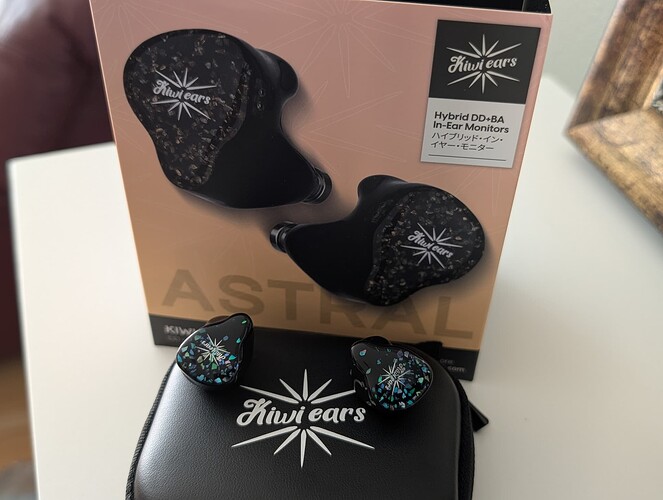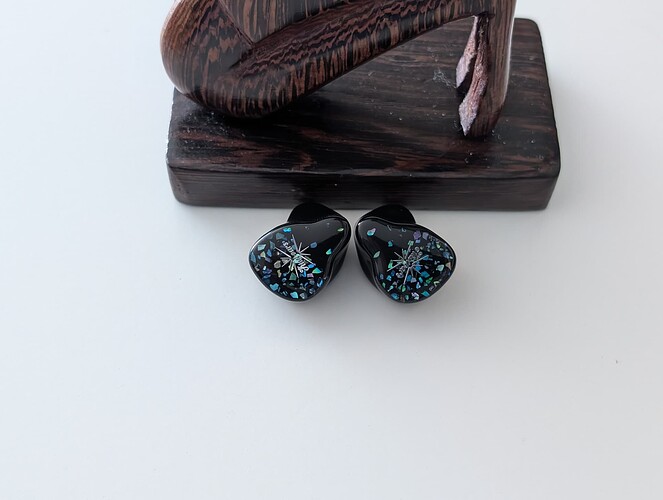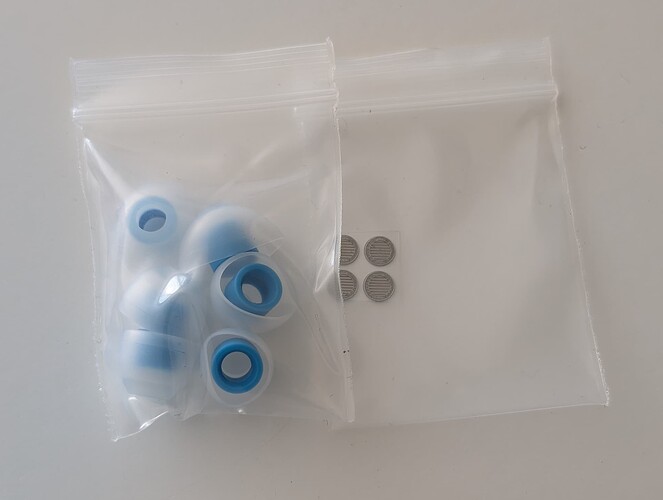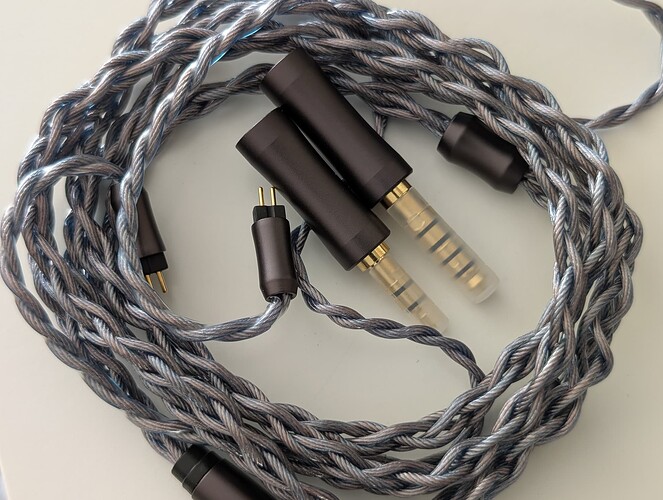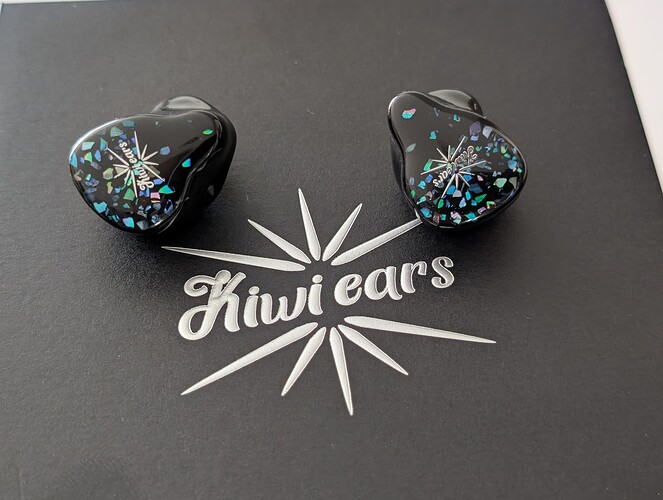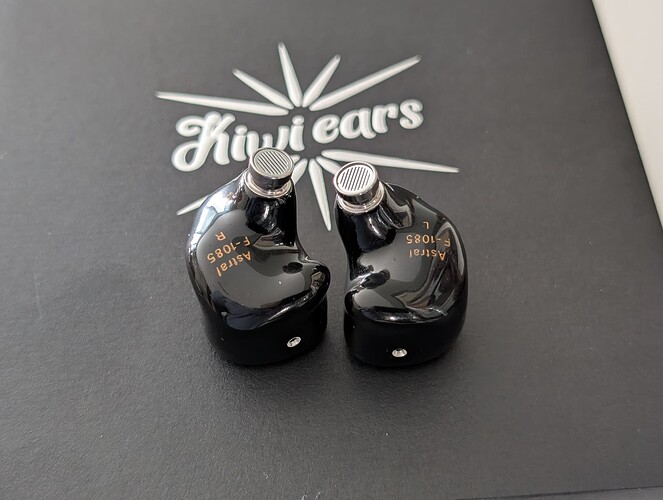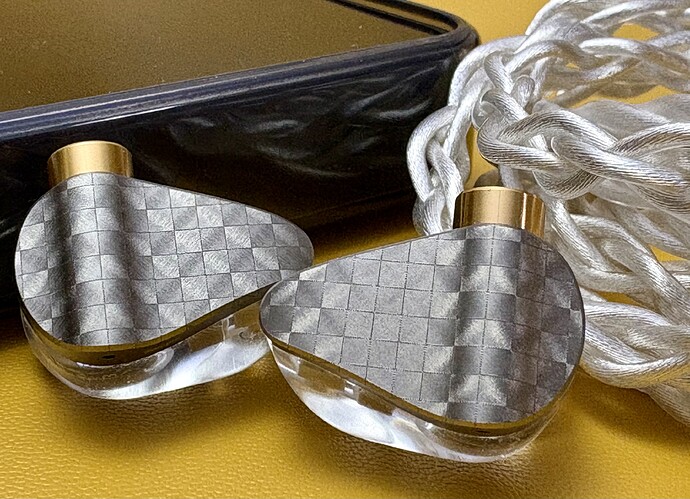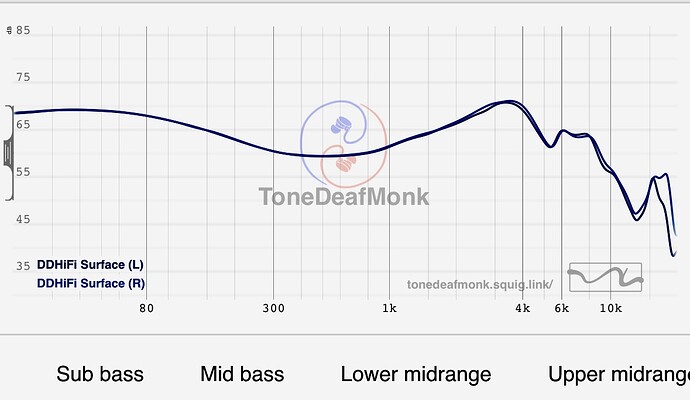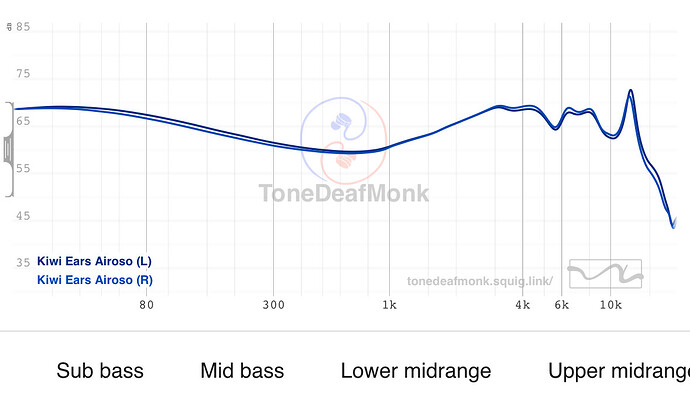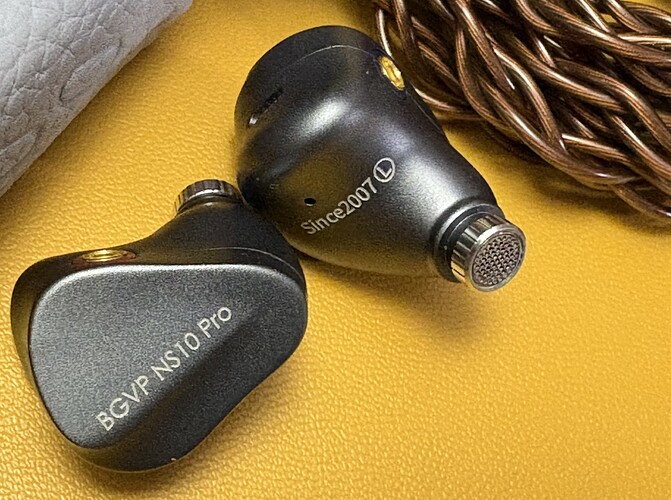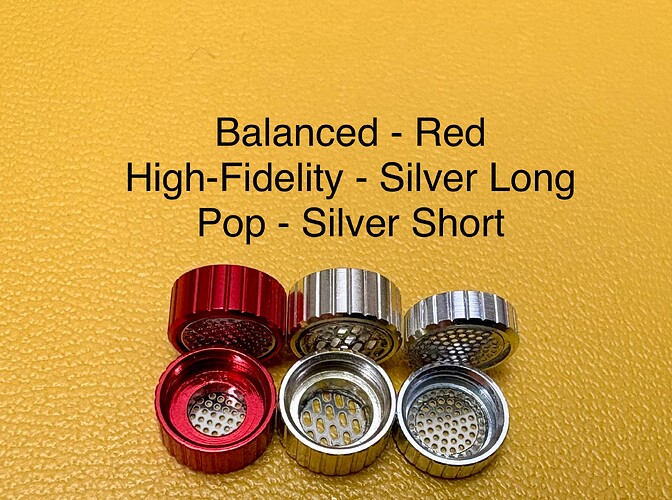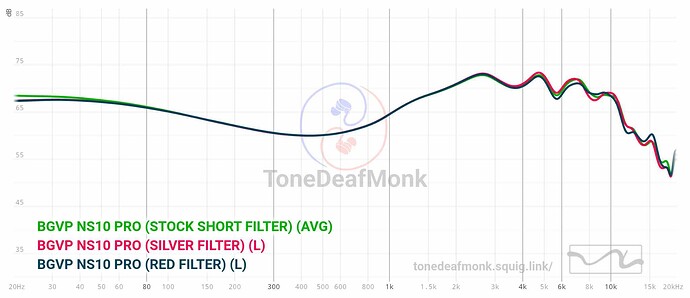BGVP NS10pro
10 driver hybrid IEM. $180.00 usd.
- 8mm silicone membrane + LCP diaphragm, copper-clad aluminum coil, N48 magnet DD for low and mid bass.
- 6mm PEN planar diaphragm, full copper coil, N52 magnet for low and mid bass.
- Sonion2300 series drivers and newly improved custom NFK-80817 BA drivers for mid range.
- Knowles RAF series BA drivers for treble.
- Newly developed NFK-80817 dual composite BA driver for treble and ultra highs.
** Quantities of each BA driver type not specified by BGVP, but there is 8 of them in total.
Impedance: 8 ohms
Frequency Response: 20Hz-40kHz
Sensitivity: 104dB SPL/mW
Distortion: <2% (1kHz)
Channel Difference: <1dB
 Preamble:
Preamble:
Shout out to fellow Canuck Audioholics Bennet Kelly and Tone Deaf Monk.
And a sincere and appreciative thank you to BGVP for providing the group with the NS10pro review sample.
I received the ear pieces, stock modular cable, carry case, and a bag of tips.
Can’t speak to the actual unboxing, but what I did receive, was all well above average.
 Pros and Cons:
Pros and Cons:
 CNC milled aviation grade aluminum shells have a classy, un-assuming look.
CNC milled aviation grade aluminum shells have a classy, un-assuming look.
They are medium small in size, and fit my “hard to fit” ears like a glove.
Comfortable and stable in ear.
 Inside those shells is a 3D-printed frame, compactly housing 10 drivers with independent three-way sound chambers.
Inside those shells is a 3D-printed frame, compactly housing 10 drivers with independent three-way sound chambers.
 4 way electronic crossover system, plus, a physical 3 way internal tube structure that further enhances physical three-way frequency separation.
4 way electronic crossover system, plus, a physical 3 way internal tube structure that further enhances physical three-way frequency separation.
 Modular, 56-core silver-plated, high-purity single crystal copper braided cable.
Modular, 56-core silver-plated, high-purity single crystal copper braided cable.
Includes 3.5 and 4.4mm terminations.

 Tuning filters (nozzles). Could be a Pro or a Con, depending on personal preference.
Tuning filters (nozzles). Could be a Pro or a Con, depending on personal preference.
You can see in the photo the three differing mesh patterns/densities, internal nozzle diameters, and lengths.
As per the FR graph the nozzle filters affect primarily the upper mids and treble ranges.
I found negligible differences between the three, although, in my experience, the “balanced” and “high fidelity” were more prone to occasional harshness or sibilance on certain recorded tracks.
I stuck with the stock “pop” nozzle filter, which I found the most refined.
(The short silver one)
 From BGVP site:
From BGVP site:
“Rich vocals, smooth highs, and exceptional clarity. This precise tuning provides balanced sound with improved separation, detail, and a fully immersive, layered audio experience”.
 Incredible staging.
Incredible staging.
 Source Devices:
Source Devices:
I rolled several DAPs and a couple “dongles”. I will note a few below.
I found the NS10pro sounded good on every source device sampled.
But, power output, and device tuning had an impact on sound, and some sounded “better” than others.
With better being a subjective term depending on personal preferences.
NS10pro is not difficult to drive, but they do scale up nicely with a capable source device.
EPZ TP35 dongle on iPhone 16 sounded good, but lacked the output power to properly maximize driver potential and failed to bring out the best of the NS10pro.
The iFi Hip DAC 3 on iPhone 16 had no problem pushing NS10pro to its full potential.
FiiO (Jade Audio) JM21 DAP powered the NS10 very well on mid gain setting.
A warmer listen with reduced, but respectable, mids/high detail, energy and clarity.
AK SP2000T set to OP amp mode was the most balanced and “musical” listen.
Tonality and timbre are natural and accurate throughout.
The ultra dark background, ample power, and high degree of clarity and detail of the iBasso DX340 proved to be my caviar.
The open spacious staging with outstanding imaging and layering was irresistible to me.
DX340 is a very resolving DAP and the NS10pro also very resolving.
Paired together the two can lean toward a clinical/monitor sound.
** Note: for those not familiar with the DX340, it comes with a 12v power adapter you can plug into the DAP.
It bypasses the battery power to the amp section and provides 12v DC power to the amp. This allows the DX340 to be put in “super gain” mode with up to 2150mW per channel @ 32ohm.
The staging and sound in super gain mode is incredible.
BGVP has done an outstanding job tuning this IEM, even without using 12v super gain. 

I’m only mentioning this as a reference to “scales nicely with extra power”.
As enthusiastic as I am for the staging the DX340 offers, I chose the natural and more “musical” tonality of the AK SP2000T for the sound evaluation
 Equipment:
Equipment:
 BGVP NS10pro IEM aged 100 + hours.
BGVP NS10pro IEM aged 100 + hours.
 Astell & Kern SP2000T set to OP amp mode, 4.4mm out.
Astell & Kern SP2000T set to OP amp mode, 4.4mm out.
 Stock SPC cable terminated 4.4mm.
Stock SPC cable terminated 4.4mm.
 Eletech Baroque extra wide bore tips.
Eletech Baroque extra wide bore tips.
 Sound:
Sound:
Short, silver “Pop” nozzle installed.
I find NS10pro has more bass presence than the FR graph indicates.
The exception being on the iBasso DX340, which really tightens up on the bass.
Bass is textured, and, well defined between sub and mid bass.
When called upon sub bass pulls low with good rumble, and a realistic head filling sub woofer presence, but stays low and doesn’t overwhelm.
Mid bass has good impact on kick and tom drums, while stringed bass instruments enjoy enough open spaciousness to express individuality without getting buried.
Bass is delivered in amounts dictated by the recorded source.
Mids and vocals are well elevated and somewhat forward, often presenting higher in the headspace than the treble and ultra highs. Clean, clear, and detailed, there is no lack of macro and micro detail here.
Tonality and timbre are accurate and natural.
The NS10pro is very much a mids focused tuned IEM, and done very well.
My take on the highs is that the upper mids are carrying most of the work load. Highs and ultra highs are mostly adding sparkle and air.
It’s executed seamlessly, and there there is no threat of harshness or sibilance. (Nozzle filter and source device may affect this)
Head stage is excellent.
NS10pro has a very dark and quiet background and an open and spacious stage.
BGVP’s engineers made the most of it.
Width is nicely outside the ears.
Mids soar high into the top of your head, and sub bass pulls down around the chin on tracks that call for it.
Front to rear depth is good, there is a nice “rounded” sense to the staging.
Imaging and layering are impeccable.
Identifying and placing instruments and vocals in the mix is well defined, precise, and accurate.
 Summary:
Summary:
If you haven’t picked up on it, I’m very enthusiastic about the NS10pro.
It ticks a lot of boxes for me.
I like good mids presence and clarity.
NS10pro offers up ample bass when the recorded source calls for it.
And while the upper most high end takes a bit of a back seat to the energetic mids, there is no lack of sparkle and air.
It plays nice with a wide range of source devices. Each adds its own personality, but all I tried sounded good.
NS10pro is easy to drive, but does scale well with extra power applied.
Great staging is NOT an absolute requirement for me to enjoy a particular IEM, but when it’s there, I thoroughly enjoy the added dimension good staging brings.
And the NS10pro brings it.
Who is NS10pro for?
Dedicated bass enthusiasts who enjoy an ever present enhanced bass sound signature will be left wanting.
But those who want the right amount of bass for the given genre or track should be satisfied.
Those who like clear, detailed, and precise mids and vocals with accurate tonality and timbre will be grinning ear to ear.
Those who don’t favour a distinct mids presence may want to reconsider.
True treble enthusiasts may find some elements lacking.
And those who appreciate excellent staging… highly unlikely you will be disappointed.
Overall the NS10pro has enough of everything that it manages to pull off a reasonably balanced, with a mids lift, listening experience.
At $180.00 usd retail for a 10 driver IEM featuring some branded drivers, high quality metal shells, good internal tech, excellent tuning (to my preference), and above average stock cable and accessories.
The NS10pro represents true value.
 My music sources:
My music sources:
Qobuz, and, FLAC and DSD files stored on the SD cards of my daps.
My music genre are primarily Rock, Blues, Jazz, Symphonic, Country, Rap, R&B, Pop, Electronic.
Enjoy your music. 
